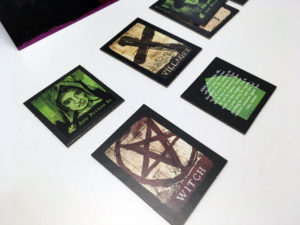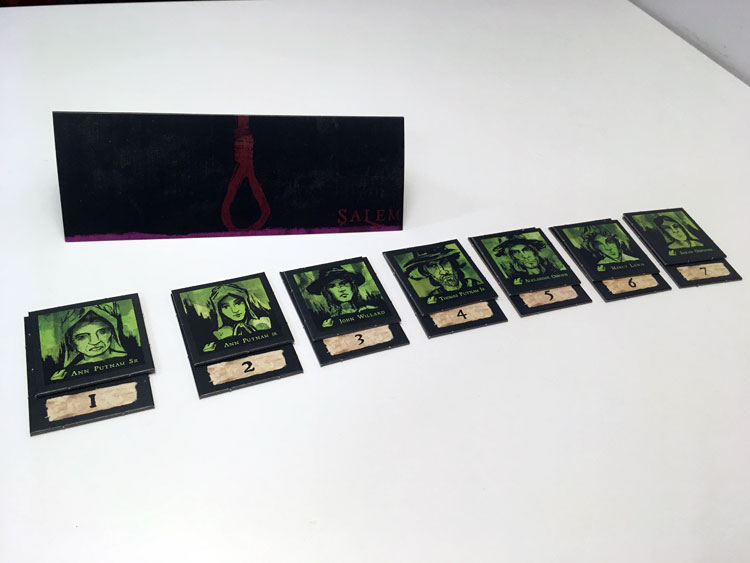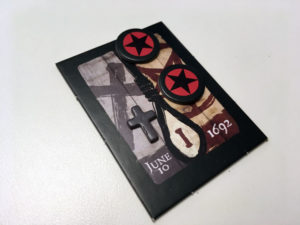 Over 300 years ago, in the small village of Salem, Massachusetts, 20 people were executed for the crime of witchcraft. Having visited Salem recently, this reviewer can attest to the town’s capitalization on the history. On more than one street visitors will find references to witch history, magic souvenirs, and other Wiccan or occult merchandise.
Over 300 years ago, in the small village of Salem, Massachusetts, 20 people were executed for the crime of witchcraft. Having visited Salem recently, this reviewer can attest to the town’s capitalization on the history. On more than one street visitors will find references to witch history, magic souvenirs, and other Wiccan or occult merchandise.
Seeing as how the events happened so long ago, it could be considered out of time and place, the utilization of what was real history seems innocuous. However, there is also a graveyard where the dead are buried, and it comes as a stark reminder that these things really did happen amongst frightened, devout, and suspicious people.
The adaptation of this to a board game may seem trite and disrespectful, but taken with the proper care, a concept can emerge that’s worthy of discussion. Designer Joshua Balvin and Passport Games took on that challenge.
Salem is a game that can be played two ways. It plays either as a complex deduction game, or as a hidden role deduction game about throwing suspicion on others while trying to discover witches lying under the control of opponents. It plays best with 7 players and takes at least 90 minutes to play.
Game Overview:

Players in Salem control a group of individuals living in the eponymous village. In the basic mode of play, a random set of individuals are laid out in the middle of the table and the object is to discover which ones are witches with deductions similar to Clue. In the more advanced mode, the witches are controlled by other players. The object is the same, to find the witches, but if you control a witch, you’re also able to penalize other players to make sure your witches aren’t caught. In each case, the player to identify the most witches wins.
Game Components:
Salem is chock full of cardboard, most of which is fair quality. There are a huge number of cardboard tiles for villagers and tiles to mark whether individuals have been accused. The publisher could have splurged a bit for the accusation tokens, used to identify witches, which are thin and easily mangled. The current player “noose” token however is thick, black wood and the sole piece of non-cardboard in the box.
The art is where the real theme shines through. The stylistic effects on the tiles give the impression of grave headstone rubbings with a haunted, morose gray palette. The illustrations of villagers also evoke misery and victimization, a somber but appropriate touch. Overall, the art excels at delivering the theme.
How to Play:
Starting a game of Salem is a complex affair. There is a rather involved setup regardless of whether or not you’re playing the full or advanced game. The character tiles are randomized and then either seven are dealt to the middle of the table (Basic Game) or all the tiles are dealt to all players (Full Game). Some of these tiles will be witches and some are innocent villagers. From there, play proceeds turn by turn.
Basic Game

In this version of the game, players are trying to deduce the innocence or guilt of the seven character cards in the middle of the table. Each player has partial information based on the characters and innocence or guilt tiles located on their characters. With each turn, a player makes an accusation against one of an opponent’s characters. That player can offer an alibi in one of three ways:
- Treachery – The player points out another character that they control which has the same status (witch or villager) as the accused and states that the two are equal.
- Slander – The player points out another character that they control which has the opposite status (witch or villager) as the accused and states that the two are different.
- Hearsay – The player points out two other characters that they control in addition to the accused and states how many witches are in that group.
After this information is given, players mark the results and the accusation on their tracking sheets. This information is used to narrow down characters witch status. If at any time a player feels they can successfully identify the witch or villager status of the seven individuals in the middle of the table, they write their accusations on the back of their tracking sheet. They will then no longer participate in making accusations but must still respond with alibis. Once half the players are prepared to make a final accusation, the game ends.
In this version of the game, the player who makes a fully successful accusation and was the earliest to do so wins the game. If no one has made a correct accusation, all players lose.
Full (Advanced) Game
The Full Game experience is similar to the Basic Game with the exception that there are no character tiles in the middle of the table. Each accusation is made against an opponent’s character. It also has some social deduction mechanisms which can be used to encourage suspicion of other player’s characters.
The full game rules are available which give a better explanation of this version of the game.

Game Experience:
From the moment gamers start playing, the main concept of Salem comes shining through. Players will be steeped in logic problems that play out like a picture slowly coming into focus. The connections between different characters and their guilt or innocence is puzzly fun, even if gamers don’t care about the lives of the wretched characters. However, at the advanced level, figuring out who is guilty or innocent for any given month is not such an improvement. Unfortunately, the added mechanisms don’t offer much more engagement.
Where Salem shines best is with higher player counts, especially at the maximum of 6 for Basic and 7 for the Full game. At anything less than the maximum, it feels like something is missing. The downside is that more players also slows down play. Even though each turn sees new information revealed, the turns can take a while to come around while people process the logic puzzle in order to make an accusation.

Another negative is the setup time and fragility of the process. This is not a straightforward “lay out some cards and game on” kind of experience. The instructions for setting up the tiles correctly is quite involved and reading through the process a couple times before play is mandatory. Even with this, on the first few plays, it’s not uncommon to make mistakes in setup that can ruin an entire game.
Where Salem really brings its A-game is with theme and the connection to the mechanisms. Were it not for the theme, this reviewer wonders whether Salem would have been produced at all. The witch trials yield perfect, haunting, and paranoid style play, even though the social deduction isn’t as tense as games like Werewolf or The Resistance.
And here lies the real stand at the gallows for Salem. The theme is appropriate, interesting, and dark. The mechanisms fit the theme perfectly. The mechanisms offer engaging play. Yet what is missing is a connection with players to each other. There’s little direct player interaction. Even in the full game the interaction is just a collection of cards and figuring out whose character is innocent or guilty. This causes the game to have a very narrow appeal. Although Salem comes together well, there’s just not enough spark to really want more than a single play (maybe two).
Final Thoughts:

As a game, Salem works. It covers its theme perfectly, it demands attention to detail (even during setup!) and players are certainly transported into a maze of suspicion and deduction. With all that being said, Salem is not a game that draws players in more than once. Part of that is the very particular theme and the other element is a narrow range, however engaging, range of game mechanisms. For the right group, this could be a gem, but that’s going to be the rare group.
If you’d like to get a copy of Salem, you can pick it up for about $30.
Final Score: 3 Stars – Salem is a great game for players interested in the subject and are looking for the most accurate gamification of it. Unfortunately, it’s mostly a one-trick pony and a pony which doesn’t have mass appeal.
 Hits:
Hits:
• Complex deduction mechanisms
• Perfect implementation of theme
• Supports larger numbers of players
Misses:
• Complex setup
• Narrow theme attraction
• Not many other mechanisms























